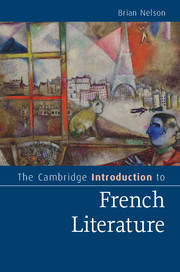Book contents
- Frontmatter
- Dedication
- Contents
- Preface
- Acknowledgements
- Chronology
- 1 Villon: a dying man
- 2 Rabelais: the uses of laughter
- 3 Montaigne: self-portrait
- 4 Corneille: heroes and kings
- 5 Racine: in the labyrinth
- 6 Molière: new forms of comedy
- 7 La Fontaine: the power of fables/fables of power
- 8 Madame de Lafayette: the birth of the modern novel
- 9 Voltaire: the case for tolerance
- 10 Rousseau: man of feeling
- 11 Diderot: the enlightened sceptic
- 12 Laclos: dangerous liaisons
- 13 Stendhal: the pursuit of happiness
- 14 Balzac: ‘All is true’
- 15 Hugo: the divine stenographer
- 16 Baudelaire: the streets of Paris
- 17 Flaubert: the narrator vanishes
- 18 Zola: the poetry of the real
- 19 Huysmans: against nature
- 20 Mallarmé: the magic of words
- 21 Rimbaud: somebody else
- 22 Proust: the self, time and art
- 23 Jarry: the art of provocation
- 24 Apollinaire: impresario of the new
- 25 Breton … Company: Surrealism
- 26 Céline: night journey
- 27 Sartre: writing in the world
- 28 Camus: a moral voice
- 29 Beckett: filling the silence
- 30 French literature into the twenty-first century
- Notes
- Further reading
- Index of authors and titles
- Index of genres, movements and concepts
- Cambridge Introductions to …
- References
25 - Breton … Company: Surrealism
Published online by Cambridge University Press: 05 July 2015
- Frontmatter
- Dedication
- Contents
- Preface
- Acknowledgements
- Chronology
- 1 Villon: a dying man
- 2 Rabelais: the uses of laughter
- 3 Montaigne: self-portrait
- 4 Corneille: heroes and kings
- 5 Racine: in the labyrinth
- 6 Molière: new forms of comedy
- 7 La Fontaine: the power of fables/fables of power
- 8 Madame de Lafayette: the birth of the modern novel
- 9 Voltaire: the case for tolerance
- 10 Rousseau: man of feeling
- 11 Diderot: the enlightened sceptic
- 12 Laclos: dangerous liaisons
- 13 Stendhal: the pursuit of happiness
- 14 Balzac: ‘All is true’
- 15 Hugo: the divine stenographer
- 16 Baudelaire: the streets of Paris
- 17 Flaubert: the narrator vanishes
- 18 Zola: the poetry of the real
- 19 Huysmans: against nature
- 20 Mallarmé: the magic of words
- 21 Rimbaud: somebody else
- 22 Proust: the self, time and art
- 23 Jarry: the art of provocation
- 24 Apollinaire: impresario of the new
- 25 Breton … Company: Surrealism
- 26 Céline: night journey
- 27 Sartre: writing in the world
- 28 Camus: a moral voice
- 29 Beckett: filling the silence
- 30 French literature into the twenty-first century
- Notes
- Further reading
- Index of authors and titles
- Index of genres, movements and concepts
- Cambridge Introductions to …
- References
Summary
Beauty will be CONVULSIVE or will not be at all.
– André Breton, NadjaThe literary precursors of Surrealism include the Marquis de Sade (1740–1814), Victor Hugo (1802–85), Gérard de Nerval (1808–55), Charles Baudelaire (1821–67), the Comte de Lautréamont (1846–70), Arthur Rimbaud (1854–91), Alfred Jarry (1873–1907) and Guillaume Apollinaire (1880–1918). The social origins of the movement lay, first and foremost, in the French experience of the First World War (1914–18). The cataclysm of the ‘Great War’ made the values and culture of the nineteenth century, with its proud belief in progress and reason, God and patriotism, seem meaningless. The very concept of ‘civilization’ was thrown into question; civilization was a sham, and this meant that art could no longer be a celebration of it. The disillusion of the younger generation of artists and intellectuals was reflected in the aggressive antiart antics of the literary movement known as Dada or Dadaism (see above, p. 176). The aim of the Dadaists was to expose the culture of the past for the nonsense the war had proved it to be. The Dadaists' leader, the Romanian poet Tristan Tzara (1896–1963), chopped up newspaper articles, pasted them in random order and called them poems. When he arrived in Paris in 1919, he was warmly welcomed by a group of young poets: André Breton (1896–1966), Louis Aragon (1897–1982), Philippe Soupault (1897–1990), Robert Desnos (1900–45), Paul éluard (1895–1952) and others. These young men, some of whom had served in the war, rejected outright the civilization that seemed to have betrayed them. Within a few years Dada had burnt itself out, but its spirit of shock and provocation carried over into the more positive concept of avant-garde art which was to become Surrealism (the word was borrowed from Apollinaire, who coined it in his 1917 programme note for the ballet Parade). Surrealism was arguably the most influential avant-garde movement of the twentieth century, international in scope and extending to every form of artistic practice from poetry and prose narrative to painting, photography, film and theatre.
- Type
- Chapter
- Information
- The Cambridge Introduction to French Literature , pp. 183 - 190Publisher: Cambridge University PressPrint publication year: 2015



